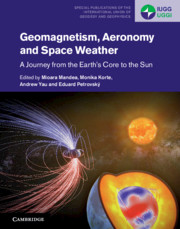Book contents
- Geomagnetism, Aeronomy and Space Weather
- Special Publications of the International Union of Geodesy and Geophysics Series
- Geomagnetism, Aeronomy and Space Weather
- Copyright page
- Contents
- Contributors
- Preface
- Part I Introduction
- Part II Geomagnetic Field
- Part III Spatial and Temporal Variations of the Geomagnetic Field
- 9 Spatial and Temporal Changes of the Geomagnetic Field
- 10 The Global Lithospheric Magnetic Field
- 11 The Ionospheric Field
- 12 The Magnetosphere
- 13 Temporal Field Variations
- Part IV Space Weather
- Part V Magnetic Fields beyond the Earth and beyond Today
- Index
- References
12 - The Magnetosphere
from Part III - Spatial and Temporal Variations of the Geomagnetic Field
Published online by Cambridge University Press: 25 October 2019
- Geomagnetism, Aeronomy and Space Weather
- Special Publications of the International Union of Geodesy and Geophysics Series
- Geomagnetism, Aeronomy and Space Weather
- Copyright page
- Contents
- Contributors
- Preface
- Part I Introduction
- Part II Geomagnetic Field
- Part III Spatial and Temporal Variations of the Geomagnetic Field
- 9 Spatial and Temporal Changes of the Geomagnetic Field
- 10 The Global Lithospheric Magnetic Field
- 11 The Ionospheric Field
- 12 The Magnetosphere
- 13 Temporal Field Variations
- Part IV Space Weather
- Part V Magnetic Fields beyond the Earth and beyond Today
- Index
- References
Summary
Since the discovery of the magnetosphere-magnetotail system in the1950s-1960s), and the associated beginning of the satellite era, we have gained a well-informed understanding of this space plasma region permeated by the geomagnetic field and home to a variety of charged particle populations and plasma waves. Over the last six decades, IAGA has played an important role in supporting international magnetospheric research. Here we provide an overview of recent developments in energy transport from the solar wind into the Earth’s environment. Topics include, magnetosphere energy input, the role of the boundary layer. Solar wind interaction with the magnetosphere creates geomagnetic activity and the response of the region leading to sub-storms and steady magnetospheric convection are discussed. The charged particle energy (eV to MeV) inherent/contained in the magnetospheric ring current and Van Allen radiation belts establish many properties of the region, giving rise to boundary regions and waves. Results from recent state of the art and currently operating Earth orbiting satellites (Cluster, THEMIS, Van Allen Probes, Magnetosphere MultiScale), are providing exciting new results. Waves from magnetospheric scale ultra-low frequency (ULF) from a few milliHertz, up to upper hybrid waves and continuum radiation in the 1-2 MHz band. Finally, current understanding of the plasmasphere and associated boundary the plasmapause, are considered.
Keywords
- Type
- Chapter
- Information
- Geomagnetism, Aeronomy and Space WeatherA Journey from the Earth's Core to the Sun, pp. 160 - 180Publisher: Cambridge University PressPrint publication year: 2019



